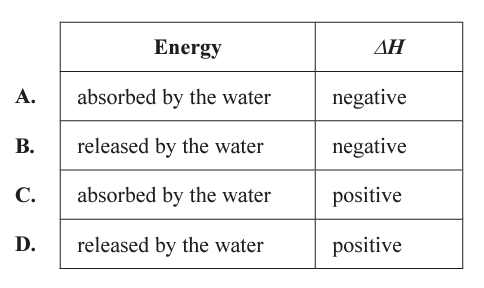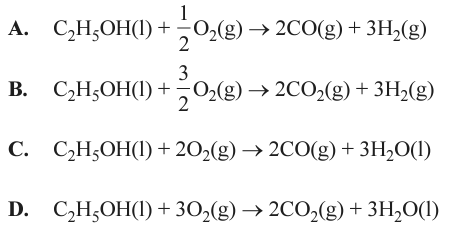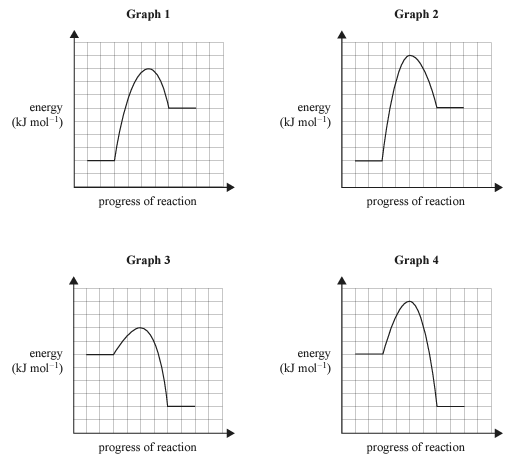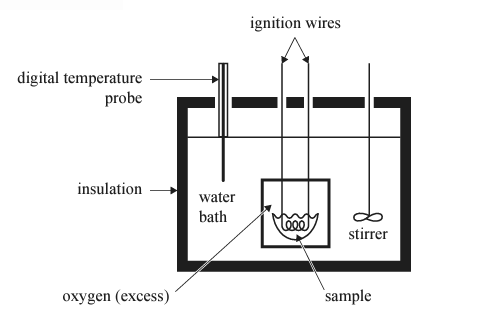1. A fuel undergoes combustion to heat water. Which of the following descriptions of the energy and enthalpy of combustion, ∆H, of the reaction is correct?

Solution

2. The correct equation for the incomplete combustion of ethanol is
Solution
3. The graphs shown below are energy profiles for the following reaction.
A + B --> C ∆H < 0
The graphs represent the forward reaction, with and without a catalyst, and the reverse reaction, with and without a catalyst. All graphs are drawn to the same scale.

Which energy profile represents the reverse reaction without a catalyst? A. Graph 1
B. Graph 2
C. Graph 3
D. Graph 4
Solution

4. Calorimeter 1 and Calorimeter 2 were each electrically calibrated. The same current, voltage and time were used to calibrate each calorimeter. A reaction was undertaken in Calorimeter 1 and Calorimeter 2. The same amount and type of each reactant was used in both calorimeters. The following temperature versus time graphs were produced for the reaction in each calorimeter.

Which one of the following statements is correct?
A. Only Calorimeter 1 can be used to calculate ∆H.
B. Calorimeter 2 has better insulation than Calorimeter 1.
C. The calibration factor for Calorimeter 2 is higher than the calibration factor for Calorimeter 1.
D. During the calibration, the temperature increase of Calorimeter 2 was greater than the temperature increase of Calorimeter 1
Solution

5. One mole of methane, CH4 , reacts with one mole of halogen, X2. X can be fluorine, F, chlorine, Cl, or bromine, Br. The general equation for the reaction is given below.

Which one of the following statements is true?
A. The strength of the bonds from weakest to strongest is C–Br < C–Cl < C–F.
B. Since hydrogen has the smallest atomic radius, the C–H bond is the weakest bond.
C. The C–Br bond is stronger than the C–H bond because of the size of the bromine atom.
D. The C–Br, C–Cl and C–F bonds are equal in strength because Br, Cl and F are halogens.
6. Researchers have identified pathways that will enable production of the biofuel
2-methylpropan-1-ol from proteins. 2-methylpropan-1-ol can be used in petrol engines. 2-methylpropan-1-ol has a heat of combustion of 36.1 kJ g-1.
i. Compare the energy content of octane and 2-methylpropan-1-ol. Explain the difference. 2 marks
Solution
ii. A small fuel burner containing 2.36 g of 2-methylpropan-1-ol was placed directly underneath a beaker containing 500.0 g of water at standard laboratory conditions (SLC). Calculate the maximum temperature that the water could reach if the contents of the fuel burner underwent complete combustion. 3 marks
Solution

7. The energy content of food can be determined experimentally using a bomb calorimeter similar to the one shown in the diagram below

a. A 1.50 g sample of air-popped popcorn is placed in the bomb calorimeter. The initial temperature of the water is 22.2 °C and the final temperature is 25.7 °C. Assume that the air-popped popcorn is fully combusted. The calibration factor for the bomb calorimeter is 6.54 kJ °C-1. Using the calibration factor provided, calculate the energy released by the air-popped popcorn in kilojoules per gram. 2 marks
Solution
b. Assume that the calorimeter was accurately calibrated so that heat loss from the calorimeter was accounted for in the calibration factor. State two factors that may contribute to a difference in the energy content that was calculated using the methods in part a. and part b. 2 marks
Solution
